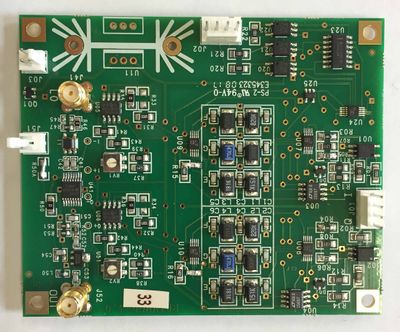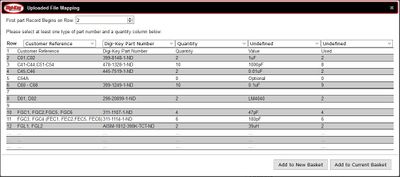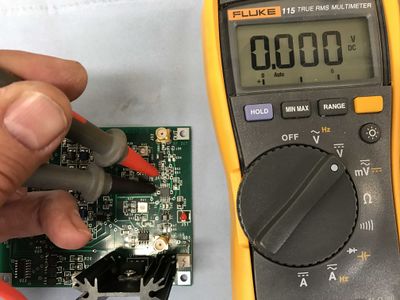Difference between revisions of "Filter Modulator build"
| (36 intermediate revisions by 3 users not shown) | |||
| Line 1: | Line 1: | ||
| − | There are 2 ways to get a Portsdown filter modulator board - ready built and tested Portsdown modulator boards | + | There are 2 ways to get a Portsdown filter modulator board - ready built and tested Portsdown modulator boards are available from the [https://batc.org.uk/shop/portsdown%20tx BATC shop] This is the easiest way to get one and each assembled board comes with it's own test report and what next instructions - see [[:File:FM Check Sheet v2a.pdf]] . |
[[File:2-3 Filter-Modulator2.jpg|400px]] | [[File:2-3 Filter-Modulator2.jpg|400px]] | ||
| + | |||
| + | |||
| + | Note: Building the board is not a beginner's construction project as the PCB contains 129 surface mount parts including ICs in dense packages. If you are not used to SMD assembly, we suggest you buy the assembled PCB from the BATC shop. | ||
| + | |||
| + | '''Even if you buy the assembled board, you will still need to fit the supplied 5v regulator'''. The heatsink is not provided and you will need to provide a TO220-38E 12.7mm (1/2") wide heatsink, the board not being designed to accept the wider 25mm (1") varieties. Suitable types include Ohmite Part No. EA-TO220-38E (Farnell code No. 2097698), or AAVID THERMALLOY Part No. ML73/38 w pins (RS Stock No. 712-4254) | ||
For those wanting to construct the board themselves, the blank PCB is available from the [https://batc.org.uk/shop/portsdowntc BATC shop] | For those wanting to construct the board themselves, the blank PCB is available from the [https://batc.org.uk/shop/portsdowntc BATC shop] | ||
| − | + | ===Board versions=== | |
| + | |||
| + | The blank PCBs supplied before 15 March 2017 are Version 1. | ||
| + | |||
| + | Assembled PCBs supplied in March 2017 are at Version 1A (modified Version 1). | ||
| + | |||
| + | Build and modification information for [[Filter Modulator Version 1A Modifications|version 1 and 1a is available here]]. | ||
| + | |||
| + | Any blank PCBs delivered after 15 March 2017 will be at Version 2. | ||
| + | |||
| + | Build information for version 2 boards is available here [[Filter Modulator ver2]]. | ||
| + | The heat sink is T220-38E pattern if needed to finish a purchased assembled board. | ||
| + | |||
| + | Information on improving the MER of earlier and home-built boards [[IQ Filter Modifications|is available here]]. | ||
| − | + | ===Parts List=== | |
| − | + | Parts list for the filter modulator board are available as bare bones parts list, or Bill of Materials, in an .xls file which you can upload to [http://www.digikey.co.uk Digikey]. | |
If you wish to make any changes such as select the larger heatsink option, use an external regulator, a different heatsink or delete components you already have, simply amend the item in the "Quantity" column before uploading to Digikey. | If you wish to make any changes such as select the larger heatsink option, use an external regulator, a different heatsink or delete components you already have, simply amend the item in the "Quantity" column before uploading to Digikey. | ||
| Line 27: | Line 45: | ||
Then simply checkout and pay Digikey and it will automatically order all the parts you require to construct the board which will arrive bagged up marked with circuit references. This is the recommended way to order your parts if you decide to build the board yourself, but you can of course order the parts from your own supplier. | Then simply checkout and pay Digikey and it will automatically order all the parts you require to construct the board which will arrive bagged up marked with circuit references. This is the recommended way to order your parts if you decide to build the board yourself, but you can of course order the parts from your own supplier. | ||
| − | |||
| − | + | ===Soldering the Small ICs=== | |
| − | + | Colin G4KLB has a done a short video showing how to solder the small ICs on to the board - it's available on the [https://www.youtube.com/watch?v=LSy3r85QB4E BATC Youtube channel here]. | |
| − | |||
| − | |||
| − | |||
| − | |||
| − | |||
| − | |||
| − | + | ===Testing the board=== | |
| − | + | Once you've completed building your own board you will have to test it - we're currently working out the process but the outline will be something along these lines. These procedures assume that you have completed the board and fitted the 5V regulator either to the heatsink on the board, or to an external heatsink. | |
| − | + | Do not connect any other modules to start with. | |
| − | + | *Using a variable power supply, with a current monitor in circuit, slowly wind up the supply voltage to the regulator, monitoring the 5V rail (on the output of the regulator). The 5V rail should stabilise at 5V as the supply to the regulator is increased above 7V. The supply current should be about 250 mA (+/- 50 mA). If the 5V rail goes above 5.2V, or the supply current is greater than 300 mA, stop the process and look for faults on the board. | |
| + | *Make sure that your ADF4351 is working with your RPi. Select IQ output mode and transmit, and you should be able to receive the carrier on a receiver or measure the frequency with a counter. Then connect the ADF4351 output directly to the filter modulator input. | ||
| + | *If all is well with the DC tests and the ADF4351, connect your filter modulator board to the RPi. Make sure that you connect the signal and return lines for both I and Q signals and the filter select lines, as these are isolated from the ground on the filter modulator board. | ||
| − | + | *Set the RPi to transmit on 1255 MHz at 2MS. Make sure that you have the output mode set to IQ. Set up a receiver (preferably MiniTioune, but a Satellite receiver will work) to receive these parameters. | |
| − | + | *Turn the RPi on and set it to transmit. You should see a signal on your receiver. If you do not see an increase in signal level, check the output of the ADF4351, and then the output of the filter/modulator. The filter/modulator output should be greater than 4 dBm (4 mW) at 1255 MHz. | |
| + | *If you get a signal, but it is not decoding, check the following in order: | ||
| − | + | - There should be 3.3v p-p 1 MHz (approx) data signals on J01 pins 2 and 4, and J01 pins 1 and 3 should be at ground. | |
| − | |||
| − | + | - There should be similar 5V p-p data signals on the hot ends of R03 and R04. | |
| − | |||
| − | + | - There should be 0.6v p-p signals on each of the test points I+, I-, Q+, Q- near U41. | |
| − | |||
| − | + | - If the I and Q signals are not present, check the DC switching of the SR filters on J02. | |
| − | + | - Check the orientation of the connections for the DC Switching of the filters on J02. The ground should be nearest the regulator heatsink and the MSB furthest away. This has caught out at least 2 constructors. | |
| − | |||
| − | |||
| − | * | + | *Adjust the balance pots – Select test signal from the console "Source" menu. Place a voltmeter between the I+ and I- test points and adjust RV1 for 0 Volts. Repeat for Q+ and Q- adjusting RV2. |
| − | |||
| − | |||
| − | |||
| − | |||
| − | |||
| − | |||
[[File:balance adjust.JPG|400px]] | [[File:balance adjust.JPG|400px]] | ||
| − | * | + | *Do not forget that you may need to rescan for new signals on a Satellite receiver. |
*If you have a MiniTiouner system, check the MER readings and make final balance adjustments. | *If you have a MiniTiouner system, check the MER readings and make final balance adjustments. | ||
| − | We are currently working out how to check for correct RF level output but there are some very interesting devices appearing on | + | We are currently working out how to check for correct RF level output but there are some very interesting devices appearing on eBay - search for "RF power meter". |
Latest revision as of 13:04, 17 September 2018
There are 2 ways to get a Portsdown filter modulator board - ready built and tested Portsdown modulator boards are available from the BATC shop This is the easiest way to get one and each assembled board comes with it's own test report and what next instructions - see File:FM Check Sheet v2a.pdf .
Note: Building the board is not a beginner's construction project as the PCB contains 129 surface mount parts including ICs in dense packages. If you are not used to SMD assembly, we suggest you buy the assembled PCB from the BATC shop.
Even if you buy the assembled board, you will still need to fit the supplied 5v regulator. The heatsink is not provided and you will need to provide a TO220-38E 12.7mm (1/2") wide heatsink, the board not being designed to accept the wider 25mm (1") varieties. Suitable types include Ohmite Part No. EA-TO220-38E (Farnell code No. 2097698), or AAVID THERMALLOY Part No. ML73/38 w pins (RS Stock No. 712-4254)
For those wanting to construct the board themselves, the blank PCB is available from the BATC shop
Board versions
The blank PCBs supplied before 15 March 2017 are Version 1.
Assembled PCBs supplied in March 2017 are at Version 1A (modified Version 1).
Build and modification information for version 1 and 1a is available here.
Any blank PCBs delivered after 15 March 2017 will be at Version 2.
Build information for version 2 boards is available here Filter Modulator ver2. The heat sink is T220-38E pattern if needed to finish a purchased assembled board.
Information on improving the MER of earlier and home-built boards is available here.
Parts List
Parts list for the filter modulator board are available as bare bones parts list, or Bill of Materials, in an .xls file which you can upload to Digikey.
If you wish to make any changes such as select the larger heatsink option, use an external regulator, a different heatsink or delete components you already have, simply amend the item in the "Quantity" column before uploading to Digikey.
To use the facility, sign in to digikey (you will need to register first) and go to my basket and follow these instructions. You then need to make the following changes:
- Change the "First part Record begins on Row" to "2"
- Use the column drop down boxes to match the first 3 column titles to the .xls file. Note the final 2 columns are for your reference only - on some tape and reel components you are ordering more parts than required as this is the most economical price break - you can change these in the .xls if you require but Digikey will then mark them as a query item.
Once finished the Portsdown BoM should look like this:
Then simply checkout and pay Digikey and it will automatically order all the parts you require to construct the board which will arrive bagged up marked with circuit references. This is the recommended way to order your parts if you decide to build the board yourself, but you can of course order the parts from your own supplier.
Soldering the Small ICs
Colin G4KLB has a done a short video showing how to solder the small ICs on to the board - it's available on the BATC Youtube channel here.
Testing the board
Once you've completed building your own board you will have to test it - we're currently working out the process but the outline will be something along these lines. These procedures assume that you have completed the board and fitted the 5V regulator either to the heatsink on the board, or to an external heatsink.
Do not connect any other modules to start with.
- Using a variable power supply, with a current monitor in circuit, slowly wind up the supply voltage to the regulator, monitoring the 5V rail (on the output of the regulator). The 5V rail should stabilise at 5V as the supply to the regulator is increased above 7V. The supply current should be about 250 mA (+/- 50 mA). If the 5V rail goes above 5.2V, or the supply current is greater than 300 mA, stop the process and look for faults on the board.
- Make sure that your ADF4351 is working with your RPi. Select IQ output mode and transmit, and you should be able to receive the carrier on a receiver or measure the frequency with a counter. Then connect the ADF4351 output directly to the filter modulator input.
- If all is well with the DC tests and the ADF4351, connect your filter modulator board to the RPi. Make sure that you connect the signal and return lines for both I and Q signals and the filter select lines, as these are isolated from the ground on the filter modulator board.
- Set the RPi to transmit on 1255 MHz at 2MS. Make sure that you have the output mode set to IQ. Set up a receiver (preferably MiniTioune, but a Satellite receiver will work) to receive these parameters.
- Turn the RPi on and set it to transmit. You should see a signal on your receiver. If you do not see an increase in signal level, check the output of the ADF4351, and then the output of the filter/modulator. The filter/modulator output should be greater than 4 dBm (4 mW) at 1255 MHz.
- If you get a signal, but it is not decoding, check the following in order:
- There should be 3.3v p-p 1 MHz (approx) data signals on J01 pins 2 and 4, and J01 pins 1 and 3 should be at ground.
- There should be similar 5V p-p data signals on the hot ends of R03 and R04.
- There should be 0.6v p-p signals on each of the test points I+, I-, Q+, Q- near U41.
- If the I and Q signals are not present, check the DC switching of the SR filters on J02.
- Check the orientation of the connections for the DC Switching of the filters on J02. The ground should be nearest the regulator heatsink and the MSB furthest away. This has caught out at least 2 constructors.
- Adjust the balance pots – Select test signal from the console "Source" menu. Place a voltmeter between the I+ and I- test points and adjust RV1 for 0 Volts. Repeat for Q+ and Q- adjusting RV2.
- Do not forget that you may need to rescan for new signals on a Satellite receiver.
- If you have a MiniTiouner system, check the MER readings and make final balance adjustments.
We are currently working out how to check for correct RF level output but there are some very interesting devices appearing on eBay - search for "RF power meter".


